Age Sixteen: Best Male Singer
210. Christian Dior
The renowned French fashion designer Christian Dior (1905–1957) grew up in an affluent family that pressured him to become a diplomat. Instead, Dior had a passion for art and fashion. As a young man, he opened an art gallery, but the Great Depression forced him to close it. He then took a job as a fashion artist for the weekly illustrated section of the newspaper Figaro Illustré. He got his start as a fashion designer by creating designs of his own while working at the fashion house of Robert Piguet, followed by work as a designer for Lucien Lelong.
After World War II, Dior was discovered by the wealthy entrepreneur Marcel Boussac, who invested the money to start a new fashion house on the Avenue Montaigne in Paris. The House of Dior shot to international fame with a revolutionary style that came to be called New Look. Dior’s clothing was a reaction against the simple and practical women’s fashions of the war years, when fabric was tightly rationed. Instead, Dior designs accentuated the female form, with narrow waists, wide hips, and long skirts. New Look clothing emphasized femininity and sensuality with striking curves and dramatic silhouettes. Dior believed that fashion should celebrate a joy and a love of life that had been missing during the war. He said: “Zest is the secret of all beauty. There is no beauty that is attractive without zest.”
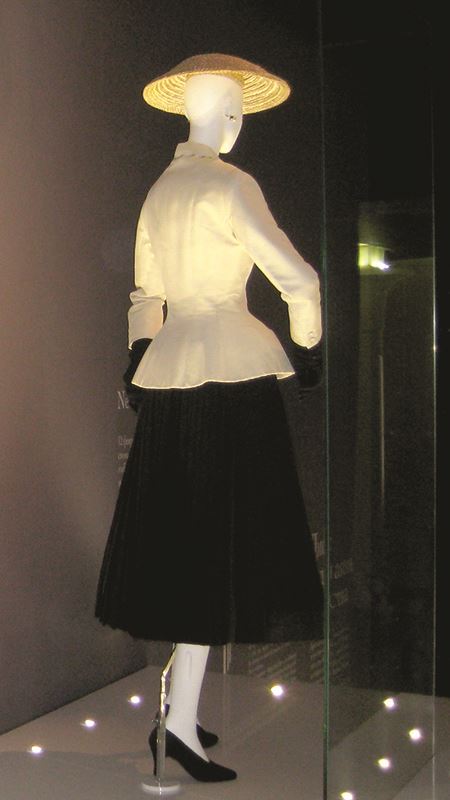
Christian Dior’s famous New Look “bar suit” design had a striking figure that took the fashion world by storm
From the late 1940s to the mid-1950s, New Look transformed styles all over the globe. In that span, it sold about 100,000 high-end garments, which accounted for some 5 percent of all French export revenues. In so doing, Dior firmly established Paris as the fashion capital of the world. Yet just as the House of Dior was at its peak, Christian died suddenly of a heart attack at age 52. Leadership of the house passed down to Dior’s 22-year-old protégé Yves Saint Laurent.
Yves Saint Laurent adapted Christian Dior’s style to be softer and more casual. Under his direction, the company remained at the height of popularity. After Saint Laurent departed and founded his own fashion house, his successors focused on preserving the brand’s distinctive look while adapting to changing times. Dior has expanded its perfume collections for men and women, and sold an increasing number of licensed accessories such as jewelry and sunglasses.
![]()
In the alternative reality of Danielle: Chronicles of a Superheroine, when Danielle attends the Grammys at sixteen as the president of China, she wears a dress and high heels, two firsts for Danielle. The Christian Dior gown, made of red and white satin, trimmed with see-through lace, had a low neckline. Over her left breast, was a discreet white and yellow iris which was copied from a Georgia O’Keeffe painting.
See entry for Georgia O’Keeffe.
211. Georgia O’Keeffe
Georgia O’Keeffe (1887–1986) was a pioneering American artist, most closely identified with images of flowers. Born in Wisconsin, O’Keeffe studied art in Chicago and New York, but did not immediately pursue a career as an artist. Instead, she worked around the country as an art teacher at schools and colleges. On the side, she continued her art as a hobby.
In the early twentieth century, most American artists, especially women, were taught a style of art that tried to be realistic. The emphasis was on mastery of the technical skills to look at an object or a scene and reproduce it. Yet O’Keeffe felt that realism was too constricting and did not allow her to fully express her own interpretations of and reactions to reality. So she started making abstract drawings with charcoal. These pieces used bold shapes, lines, and shading to create images unlike anything viewers had seen before.

Georgia O’Keeffe, one of the first female artists to both achieve enduring influence within the art world, and gain broad recognition in popular culture
Alfred Stieglitz, the owner of a top New York fashion gallery, saw O’Keeffe’s work in 1916 and immediately recognized her talent and originality. Stieglitz organized showings of her work at his famous 291 gallery, and O’Keeffe soon found her work in high demand. Through Stieglitz, she became part of an artistic group that included modernist painters Arthur Dove and Charles Demuth, and photographer Edward Steichen. In 1924, O’Keeffe and Stieglitz married.
Although she was fast becoming one of the foremost artists in America—at a time when almost all of her peers were men—O’Keeffe wanted fresh inspiration. She was mainly known for abstract art and images of New York skyscrapers, and sought to reconnect with nature. So she traveled to New Mexico in 1929, and was overwhelmed by the beauty of the environment there. This began an ongoing connection to the state, first as a seasonal painting retreat, and ultimately as her home for the last few decades of her life.
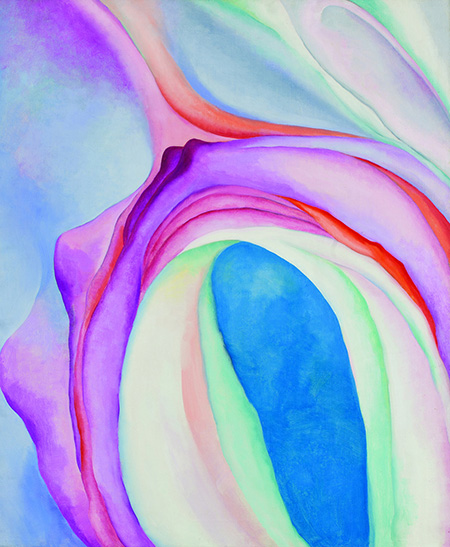
Georgia O’Keeffe’s famous painting Music, Pink and Blue No. 2 (1918)
O’Keeffe combined highly detailed imagery with rich symbolism that inspires much discussion to this day. Her style used vivid colors and sharp contrasts to explore intricate shapes and textures. Common subjects of her paintings included animal skulls and bones, mountains, desert landscapes, and the open sky. But the theme most central to O’Keeffe’s art was flowers.
Until O’Keeffe, artists usually painted flowers from a distance in ordinary situations such as arranged in vases or growing wild in the fields. By contrast, O’Keeffe painted flowers in intense close-ups that could be startling and disorienting for viewers. Sometimes, she enlarged the tiniest details of a flower to fill an entire painting, so that the shapes of individual petals and capillaries almost looked like abstract art.
Many observers and commentators interpreted the flowers in O’Keeffe’s art as symbolizing and celebrating the female genitals. During her career, the psychological theories of Sigmund Freud (1856–1939) were extremely popular, and so the erotic and sexual interpretation of O’Keeffe’s flower paintings resonated with the interest in Freud’s theories. This influenced other artists, and even the English language, where flower-related words became more commonly used as metaphors for female sexuality. O’Keeffe herself always insisted that this was not an intended meaning of her work, but her position was widely considered implausible (including by this author).
![]()
In the alternative reality of Danielle: Chronicles of a Superheroine, when Danielle attends the Grammys at age sixteen, after being elected president of China, she wears a discreet white and yellow iris image over her left breast on her Dior dress. A blogger quickly identifies this as copied from a Georgia O’Keeffe painting.
See entries for Sigmund Freud, the unconscious, and Christian Dior.
212. The Apartheid of Sex
In the early 1990s, satellite technology executive Martin Rothblatt told his wife Bina that he felt his soul had always been female and that he wanted to live openly as a woman named Martine. Bina was completely supportive and said, “I love your soul, and whether the outside is Martin or Martine, it doesn’t matter to me.” And so, Martin became Martine, who went on to become a pioneer in biotechnology, a visionary of the future, and the highest-paid female CEO in America.

Martine Rothblatt’s 1995 book The Apartheid of Sex
When Martine Rothblatt came out as transgender, she wanted to create a wider conversation about what gender means. In 1995, she authored a book called The Apartheid of Sex, arguing that most of the differences between males and females in society are social constructs. This means there is not an unavoidable biological reason why American boys usually play with balls and girls play with dolls. Instead, the culture teaches young boys to act one way, and girls another. Social pressure reinforces this by rewarding boys who do things that fit masculine stereotypes, while punishing them for doing things that fit feminine stereotypes, with the opposite happening for young girls.
If gender is a social construct, this implies that social changes could end these pressures to conform to gender stereotypes. Rothblatt suggests ways of reducing the dominance of the binary idea of male versus female gender. For example, she recommends altering language so as not to require thinking about people as either masculine or feminine—replacing “she” and “he” with “heesh,” and “him” and “her” with “hirm.”
Rothblatt argues that each person naturally expresses gender differently. For this reason, she says that the strict gender binary in society can be harmful, forcing them into restrictive categories. She compares this to the racial apartheid system that used to exist in South Africa, where the law divided people into categories of Blacks, Whites, Coloureds, and Indians. These categories didn’t have a true scientific basis, but were social constructs based largely on appearance. Nonetheless, which category a person was in dictated their social and legal standing. Even basic facilities such as bathrooms were rigidly segregated by racial categories. According to Rothblatt, reserving some facilities only for men and some only for women makes a similar type of mistake similar to apartheid in South Africa.
In The Apartheid of Sex, Rothblatt calls for wider acceptance of people of all sexual identities. The book was influential in shaping the global conversation about gender, and contributed to the growing prominence and visibility of the transgender movement in America.
![]()
In the alternative reality of Danielle: Chronicles of a Superheroine, when Danielle accepts a Grammy nomination for Best Male Singer, a controversy erupts. Some people wonder why a teenage girl should be eligible in that category. In response, Danielle posts a tweet recommending that people read Martine Rothblatt’s The Apartheid of Sex.
See entries for Martine Rothblatt, and Plasticity of the neocortex.
How You Can Be a Danielle and promote racial and gender equality.
213. Zhongnanhai
Zhongnanhai is a complex of palaces and government buildings centered around two small lakes in the Imperial City area of Beijing. First built during China’s Ming Dynasty (1368–1644), Zhongnanhai housed members of the imperial household and their most trusted supporters. It was conveniently located across from the emperors’ residences in the Forbidden City, and its lakes and gardens provided a beautiful and tranquil escape for the elites of several dynasties.
When Mao Tse-tung (1893–1976) founded the People’s Republic of China in 1949, the communist government took over Zhongnanhai as its headquarters compound. In addition to major offices of the Party and Government, many of China’s most senior officials also lived there. Over time, Zhongnanhai came to be used as a figure of speech referring to the communist government itself, much like how people speak of the White House to refer to the president of the United States and the top of the executive branch of government.
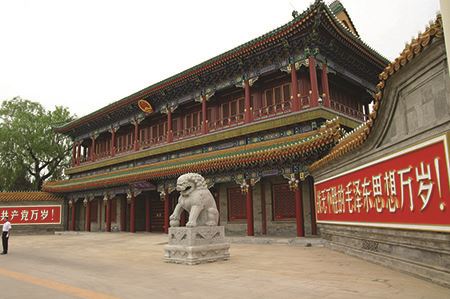
Xinhua Gate, Zhongnanhai
Access to the compound has usually been restricted, and ordinary Chinese people are not permitted to enter freely. For this reason, Zhongnanhai has sometimes been called China’s “New Forbidden City.” When foreign dignitaries such as heads of state visit Beijing, they are often invited to Zhong-nanhai for meetings with senior Chinese leaders.
![]()
In the alternative reality of Danielle: Chronicles of a Superheroine, when Danielle is elected president of China at age fifteen, she moves into the Zhongnanhai. Claire and her fiancé Charlie move into separate accommodations there as well.
See entries for Ming Dynasty, Forbidden City, Mao Tse-tung, and Chinese Communist Party.
How You Can Be a Danielle and promote democracy in China.
214. Ming Dynasty
The Ming dynasty ruled most of China from 1368 to 1644. It was founded after almost a century of domination by the Mongol Yuan dynasty, when a former peasant-monk named Zhu Yuanzhang rose to command of the anti-Mongol resistance armies in southern China. Zhu united the rebels and invaded the north, driving the Mongols out of their capital in what is now Beijing. Zhu proclaimed the start of a new Han Chinese-led dynasty, with himself as emperor under the name Hongwu.
As emperor, Hongwu focused on restoring Han Chinese culture and Confucianism, while suppressing the culture and religion of the Mongol occupiers. He introduced sweeping reforms across China, reorganizing the military, the bureaucracy, and the legal system. He established a new education system, promoted diplomacy, and undertook major building projects. His agricultural reforms dramatically increased the amount of useful farmland in China, which led to a sudden population boom and rapidly improving living standards. As a result, peasants gained greater freedom and opportunity. Toward the end of his reign, though, Hongwu became highly paranoid, and ordered the execution of tens of thousands of people suspected of disloyalty.
The next major Ming emperor was Hongwu’s son Zhu Di, who became known as the Yongle emperor. Yongle reformed the civil service to emphasize merit, so that even poor people could sit for examinations and advance up the ranks of government through skill and hard work.
He also ordered even greater construction projects than his father, and moved the empire’s capital from Nanjing in the south to Beijing in the north. There, he built the massive complex of palaces, temples, and government buildings that came to be known as the Forbidden City. In addition, he ordered reconstruction and expansion of the Grand Canal, an artificial waterway linking Beijing to the Yellow River (or Huang He), Yangtze River, and the port city of Hangzhou on the East China Sea. This required technological innovation in designing locks to move vessels across the canal. Once completed, though, it lifted China to new wealth and prosperity.
Yongle is also known for his achievements in knowledge and exploration. He commissioned thousands of scholars to create an encyclopedia known as the Yongle Dadian. When completed four years later, it had 22,937 chapters, covering virtually every subject of learning. It was the largest encyclopedia in history, and only surpassed centuries later by Wikipedia. Yongle also dispatched seven “treasure fleets” all over the known world on missions of exploration, trade, and diplomacy. Commanded by the eunuch admiral Zheng He, huge ships showed off China’s wealth and prestige throughout Southeast Asia, India, Arabia, and East Africa.
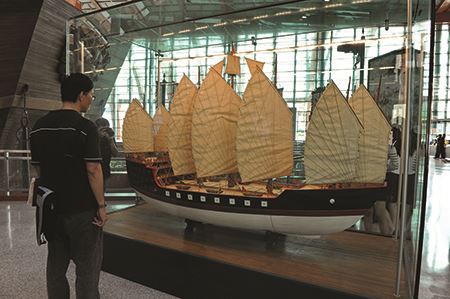
A model of one of Admiral Zheng He’s treasure ships, compared to a European ship from the same period
Following Yongle, the Ming dynasty continued under a series of less successful emperors. During this period, China was the largest and most powerful nation on earth. There was relative peace and stability for more than two centuries, but as the Mings declined, rebellions flared up. In 1644, the rebel general Li Zicheng overthrew the Ming Dynasty, and was himself soon defeated by armies from Manchuria in the north. The invading Manchus established the Qing Dynasty, which ruled China until it became a Republic in 1912 during the Xinhai Revolution.
Historians look back on the Ming Dynasty as a period of rich cultural development. The arts flourished, including decorative furniture and carvings made out of jade or ivory. Painting focused on landscapes and nature scenes.
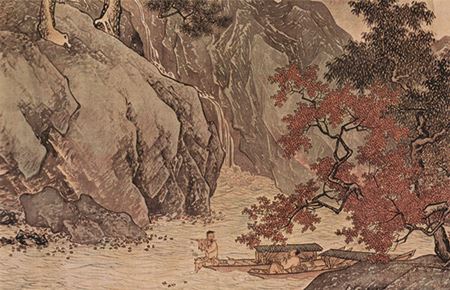
A representative example of painting from the Ming dynasty, which emphasized tranquil landscapes and images of mountains, trees, and rivers
Ming-era pottery is famous for its simple and elegant shapes. Ming vases were often made of white porcelain, decorated with intricate blue patterns of flowers, trees, or animals. Following the treasure voyages of Admiral Zheng He, Chinese pottery incorporated more designs influenced by other cultures. For example, some Ming potters experimented with the abstract geometric shapes common in the Islamic art of Persia and Arabia, leading to a blending of cultural art forms.

A classic example of Ming pottery: a blue and white porcelain vase, decorated with images of flowers and flying dragons
The literature of the Ming dynasty became less formal and more accessible to ordinary people than in previous eras. Three of the Four Great Classical Novels in Chinese were completed during the Ming period: Journey to the West, Romance of the Three Kingdoms, and Water Margin. These works share many similarities with modern novels and were written to be exciting adventure stories. Water Margin was written in vernacular Chinese instead of Classical Chinese, and sparked a trend of writing novels in everyday language. Metal movable-type printing made it possible to reproduce books more affordably than before. Meanwhile, as more people learned to read and write, written poetry became a widespread art form enjoyed by many people in Chinese society.
Although there were some technological achievements during the Ming Dynasty, the overall pace of innovation was slower than previous eras. For example, the Song Dynasty (960–1279) saw an explosion of inventiveness, creating technologies like gunpowder, the printing press, paper money, and multistage rockets. By contrast, while Europe was experiencing the Renaissance and rapid technological progress, Ming-dynasty China stagnated in terms of technology. The historian Samuel Huntington called this the “Great Divergence.”
Scholars have struggled to explain why the Great Divergence took place. At the time emperor Hongwu took power, China was more technologically advanced than Europe, and had higher living standards. So why didn’t China stay ahead? There are many different explanations, but the most popular view comes from anthropologist Jared Diamond. He argues that because Ming China was a single united empire with weak neighbors, it had little incentive to innovate. Europe, on the other hand, was full of smaller states in competition with each other. New ideas and technologies were necessary for survival, and this incentive caused Europe to have a scientific revolution.
![]()
In the alternative reality of Danielle: Chronicles of a Superheroine, when Danielle becomes president of China at fifteen, she moves to the Zhongnanhai palace complex built near Beijing’s Forbidden City, which was built during the Ming Dynasty.
See entries for Han Chinese, Forbidden City, Zhongnanhai, and Mandarin.
How You Can Be a Danielle and promote democracy in China.
215. Forbidden City
When Zhu Di became the Yongle emperor of China, he decided to move his capital from Nanjing in the south back up north to the city that is now Beijing. It had formerly been the capital of the Mongol Yuan dynasty, under the name Khanbaliq. Yongle wanted to remake the city according to his own plans. So he ordered construction of a vast complex of palaces, temples, and government buildings that came to be known as the Forbidden City.
Yongle brought in skilled artisans and precious materials from all over the empire for the project. About a million laborers constructed the Forbidden City over 14 years. When it was finished, it was the largest complex of its kind in the world, and was the heart of Chinese government for almost five centuries. Although it suffered fires and damage over the years, it has been carefully repaired and rebuilt. In total, the Forbidden City has 90 palaces and courtyards, divided into 980 buildings, which have an estimated 8,704 rooms. The complex is surrounded by a moat and high walls. It acquired the “Forbidden City” name because commoners were usually not allowed to enter.
I have personally walked through the Forbidden City, which is about two miles across.
Most of the Forbidden City’s buildings are made of wood, with the most important structures set on marble platforms, and paved with special clay bricks that fit together perfectly. The halls and gardens are highly ornamented, with decorative wooden carvings, elaborate paintwork, and gilded details. They are the pinnacle of Chinese art and architecture.
The mostly symmetrical layout of the Forbidden City follows the principles of Confucian philosophy and the I-Ching text of Taoism. The buildings are laid out in a strict hierarchy that reflects their purpose and status. The Ming believed that these palaces were replicas of heavenly palaces, and saw the Forbidden City as a meeting point between the normal world and the divine.
The main exterior entrance of the Forbidden City is called the Meridian Gate. It has five archways, and the central one was normally reserved for the emperors alone. Inside is a large open plaza with bridges crossing a ceremonial river, followed by the Gate of Supreme Harmony. This was formerly the site of major imperial court functions. Beyond this gate is the Hall of Supreme Harmony, the largest and grandest palace in the complex.
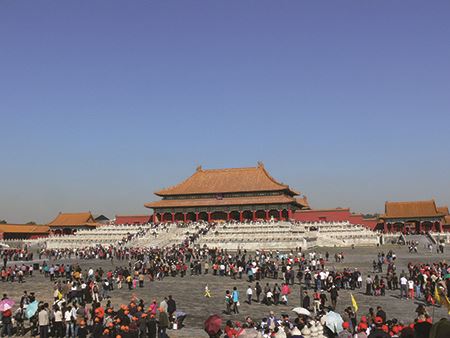
Hall of Supreme Harmony, Forbidden City, Beijing. The building is now the centerpiece of the Palace Museum complex
The Hall of Supreme Harmony rises about 90 feet above the plaza below, and contains the main throne room of the emperors. At its heart is the famous Dragon Throne, considered during imperial China to be the center of the world.
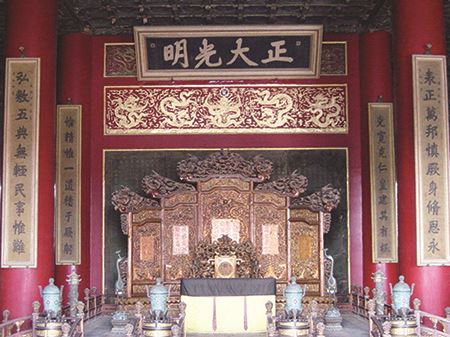
The Dragon Throne, ceremonial seat of the Chinese emperors for centuries
Beyond the Hall of Supreme Harmony are two more large palaces: the Hall of Central Harmony and the Hall of Preserving Harmony, which were used for audiences and rituals. All these areas form the Outer Court of the Forbidden City, which was for official events. Beyond this is the Inner Court, which was for the imperial family’s personal life. The Palace of Heavenly Purity was the emperor’s lavish residence, but later Qing dynasty rulers spent most of their time in the smaller Hall of Mental Cultivation. Nearby is the Palace of Earthly Tranquility, which in Ming times was the residence of the empress.
Now that China is no longer an empire, the Forbidden City has been converted into a museum complex that holds over 1.8 million items. These include sculptures and pottery dating back over 5,000 years of Chinese history. There are jade carvings, metalwork, paintings, and calligraphy. There are also rich collections of imperial inscriptions, ceremonial objects, and artifacts from the Chinese emperors and their courts. Millions of tourists visit the Palace Museum each year.
![]()
In the alternative reality of Danielle: Chronicles of a Superheroine, when Danielle becomes president of China at age fifteen, her residence in the Zhongnanhai palace complex is near the Forbidden City. Liu lives in a separate condominium on Wangfujing Street, also close to the Forbidden City.
See entries for Han Chinese, Ming Dynasty, Zhongnanhai, and Mandarin.
How You Can Be a Danielle and promote democracy in China.
216. Society of Mind
The American cognitive scientist and AI theorist Marvin Minsky (1927–2016) is one of the founders of the artificial intelligence field. The term “artificial intelligence” was coined by Minsky and John McCarthy at a 1956 conference at Dartmouth. He was one of the key figures in the development of artificial neural networks, but subsequently became known as the leader of the “symbolic” school of artificial intelligence, which attempted to define intelligent problem solving in terms of logical rules.
While a professor at MIT, he wrote an influential 1986 book called The Society of Mind. In it, Minsky proposed a new theory for how to understand the human mind and the mental experiences people have.
Minsky’s central idea is that although the mind as a whole is intelligent, it is made up of smaller parts that follow simple rules. He argues that human intelligence can be explained by the interactions of layers of simpler and simpler parts he calls “agents.” He gives the example of a child building a tower out of blocks. One agent in the child’s mind is called the Builder, and is responsible for tasks involving building things. No single agent can manage a task that complicated, so Minsky says Builder needs to get help from simpler agents like See to recognize the blocks, Move to extend the arm, and Grasp to pick it up. Each one of those is in turn made up of simpler agents, and those made of even simpler agents. Eventually, these agents would get down to units that follow basic rules of logic, just like transistors on a computer chip or neurons in a human brain.
In the book, Minsky does not link these agents to specific structures in the brain, but Minsky’s theory can be aligned with other theories of mind including my own Pattern Recognition Theory of Mind (PRTM) which I articulate in my book How to Create a Mind. Although these basic agents are not intelligent themselves, they interact in complex hierarchies that create intelligence. In a sense, the agents are collectively making decisions, much like people do in society, hence the name of the theory.
Minsky was my lifelong mentor. I met him in 1962 when I was fourteen. I wrote him a letter and he invited me to visit him at MIT, which I did. He spent much of the day with me as if he had nothing else to do as he was the consummate educator. I then went to MIT in 1965 to study with him and he became my mentor for the next half century until his passing in 2016.
His theory of Society of Mind influenced my own 2012 book How to Create a Mind, where I describe how the neurons of the neocortex are arranged into roughly 300 million “pattern-recognition modules” structured into hierarchies. These modules take input stimuli, either from our senses or from other modules, and based on the recognition of a sequential pattern, send an output signal to a module at a higher level of the hierarchy. For example, one module might function by deciding whether a shape matches the printed letter “A” and then sending a positive signal up the hierarchy to the next model (which might recognize the printed word “Apple”) whenever it recognizes an A. These modules are organized into increasingly complex hierarchies which is consistent with Minsky’s theory.

Marvin Minsky, author of The Society of Mind and originator of the Society of Mind theory
Minsky’s Society of Mind theory was a major contribution to the connectionist school of artificial intelligence, which seeks to build models of neural networks that learn problem-solving based on examples. This is in contrast to the symbolic school, which thinks of intelligence as solutions to logical and symbolic equations. Minsky has gone back and forth between his support of these two schools of thought. In the early 1950s, he wrote the first neural net program, but then in 1969 he was deeply critical of it in his book Perceptrons which he coauthored with Seymour Papert. That book proved a theorem that a perceptron (a neural net) was unable to solve the “connectedness problem,” basically the ability to distinguish an image that is connected from one that is not. This book was influential in discouraging funding for the connectionist field for about twenty years. Minsky was then associated with leadership of the symbolic school of AI.
It turns out that the theorem only applies to single level neural nets and the recent success of connectionism uses neural nets with many levels. Thanks to advances in the mathematics of neural nets and exponential progress in the price-performance and capacity of computation in the last decade, artificial neural networks have gone from only three or four layers deep to hundreds of layers. This allows for much more sophisticated—and humanlike—levels of subtlety and abstraction. Thanks to these advances, AI has achieved impressive breakthroughs, such as IBM’s Watson mastering the quiz show Jeopardy!, self-driving cars, and Google DeepMind’s AlphaGo defeating the human champion of the board game Go.
In recent years, Minsky confided to me that he regretted the “success” of his book Perceptrons in discouraging funding for connectionism and that he had become more enthusiastic about the approach.
![]()
In the alternative reality of Danielle: Chronicles of a Superheroine, when Danielle and Claire are talking about Danielle’s feeling about dating, Danielle uses Minsky’s metaphor of the Society of Mind and tells Claire that her society of mind is bickering about whether she wants young men to try to go further than a kiss with her. She points out that “there are different factions in my mind on that subject.”
See entries for Artificial Intelligence, Plasticity of the neocortex, and Neocortex.
How You Can Be a Danielle and advance artificial intelligence.
217. India’s Hindu-Muslim conflict
The first Muslim contact with India happened during the lifetime of the Prophet Muhammad (570–632), but it took several centuries for a large Islamic population to form there. During the late twelfth century, peoples from what is now eastern Iran began invading the Indian subcontinent, leading to the establishment in 1206 of the Delhi Sultanate. This Islamic kingdom ruled much of what is now northern India for three centuries. In 1526, the Delhi Sultanate was conquered by Turkic peoples from Central Asia, who descended from the Mongols. They set up the Mughal Empire, which soon expanded to include modern-day Pakistan and Bangladesh, and all but the southern tip of India. The Mughals were Muslim, but practiced religious tolerance, so there was relative peace between the empire’s Muslims, Hindus, and other religious groups. Akbar the Great, who ruled the empire from 1556 to 1605, was famous for encouraging dialogue between faiths, and he promoted a philosophy of religious harmony called Sulh-i kul, meaning “universal peace.”
During the eighteenth century, the British gradually took control of India, and ruled it through a corporation called the East India Company. Two major nations remained independent: the Hindus in the Maratha Empire, and the Muslims in the Kingdom of Mysore. Both countries fought bitterly, sometimes forcibly converting people to their own religion. Tipu Sultan, the most famous ruler of Mysore, was notorious for persecuting Hindus and forcing them to eat beef, which is forbidden in their religion. The British ultimately conquered both Mysore and the Marathas, but Hindu-Muslim religious tensions continued.
In 1858, the British government toppled the last remnants of the Mughal Empire, and took over from the East India Company direct colonial rule of the whole of India. The British acted sternly to suppress violence and rebellion, but the movement for self-rule by Indians gradually grew stronger. In response, in 1905 the British partitioned the province of Bengal into East Bengal for Muslims and West Bengal for Hindus, following a policy that came to be known as “divide and rule.” The partition provoked serious tensions between the Hindus and Muslims, and led to such extensive protesting and violence that the British undid the partition just six years later. Still, periodic waves of riots hit India in the following decades, up through the 1940s.
During World War II, the British relied on support from India in the form of soldiers and raw materials. This gave the Indians bargaining power, and they were ultimately able to get the British to agree to grant India its independence. Yet the Islamic population was concerned that their rights would not be protected in a majority-Hindu nation. So they formed the Muslim League, which advocated an independent homeland for India’s Muslims. The League’s leader, Muhammad Ali Jinnah, realized that most Hindus wanted India to remain united, so he called for a “Direct Action Day” on August 16, 1946. The protests quickly escalated into riots and indiscriminate killing of Hindus in Calcutta (modern-day Kolkata) and elsewhere. Several thousand people were killed, but that was only the beginning.
Over the following year, violent mobs from both sides looted and burned each other’s communities. It soon became clear that a united India would be impossible, so the British established a commission to draw up borders that would partition India’s Muslim and Hindu populations. The commission produced the so-called Radcliffe Line, named after its chairman, which set aside Muslim homelands, one in East Bengal and another called Pakistan in the Punjab region to the northwest.
At the stroke of midnight on August 15, 1947, tens of millions of Hindus and Muslims found themselves on the wrong side of the new borders. Muslims living in India and Hindus living in Pakistan and East Bengal were suddenly outsiders in their own lands. Armed crowds began attacking and killing anyone they could find of the other faith. Families abandoned their homes and belongings and fled to safety on jam-packed refugee trains, or by long journeys on foot. Historians estimate that about 15 million people were displaced from their communities, and between one and two million people were killed.
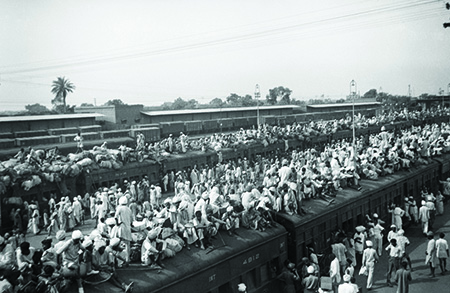
Train full of refugees during the partition of India in 1947
Since the partition of India, large-scale violence has subsided, but there has still been periodic rioting and terrorism. In 1969, anti-Muslim riots in India’s western state of Gujarat killed about 500 people. Other major religious riots occurred in 1987, 1992, and 1993. In 2002, a train full of Hindu pilgrims was attacked by a largely Muslim mob and set on fire in Godhra, Gujarat. Fifty-nine people died, and in response there were severe anti-Muslim riots that left over a thousand people dead in total. According to Human Rights Watch, government authorities in Gujarat turned a blind eye to the violence or even encouraged it. This has been an ongoing source of controversy because the Chief Minister of Gujarat during the riots, Narendra Modi, has since been elected prime minister of India.
More recent violence includes the 2006 bombing of trains around Mumbai, India by a Muslim terrorist group called Lashkar-e-Taiba (Army of the Righteous). The blasts killed about 200 people and wounded over 700 more. Fortunately, this was not followed by the wave of anti-Muslim violence that many feared. Similarly, in 2008, Lashkar-e-Taiba operatives stormed two hotels and several nearby buildings in Mumbai, killing 164 people in a four-day siege. Once again, the feared retaliatory violence did not happen. The latest major Hindu-Muslim riots happened in 2013 in Muzaffarnagar in the northern state of Uttar Pradesh, killing 42 Muslims and 20 Hindus. Overall, though, many leaders of India’s Muslim and Hindu communities are optimistic that the conflict is gradually lessening.
![]()
In the alternative reality of Danielle: Chronicles of a Superheroine, as president of China, fifteen-year-old Danielle works to improve relations between her country’s 56 ethnic groups. She realizes that although there is still tension between them, the lingering animosity between Muslims and Hindus in India is significantly worse.
See entries for the East India Company, Shiite, Sunni, and Sunni terrorist groups.
218. Caste system
For over 3,000 years, Indian society has been divided into hereditary social classes known as castes. Called varnas in Sanskrit, these castes determined the jobs someone could have, whom they could marry, and what rights they had in society. For most of India’s history, there were four main castes: priests, warriors, merchants/farmers, and laborers. A fifth group consisted of those without a caste, known as “untouchables” because they were considered impure. These rules were formalized around the first century AD in a set of scriptures called the Laws of Manu.
The priestly class is called the Brahmin caste, and includes scholars and other intellectuals. According to Hindu tradition, only the Brahmins were pure enough to perform certain religious rites. This required them to follow additional rules not required of others, such as most Brahmans eating a vegetarian diet, taking frequent baths, not touching unclean substances, and avoiding physical contact with people from lower castes. In return, the other castes looked to the Brahmins as teachers, advisors, and spiritual leaders.
Although the Brahmins had the spiritual power, the political and military power was held by the Kshatriya caste. These were India’s kings, princes, and warriors. Just as it was considered the duty of the Brahmins to study religious matters and stay extremely pure, it was the duty of the Kshatriyas to govern and defend the people in the other castes. They were expected to be courageous, to develop strong bodies, and to train for war.
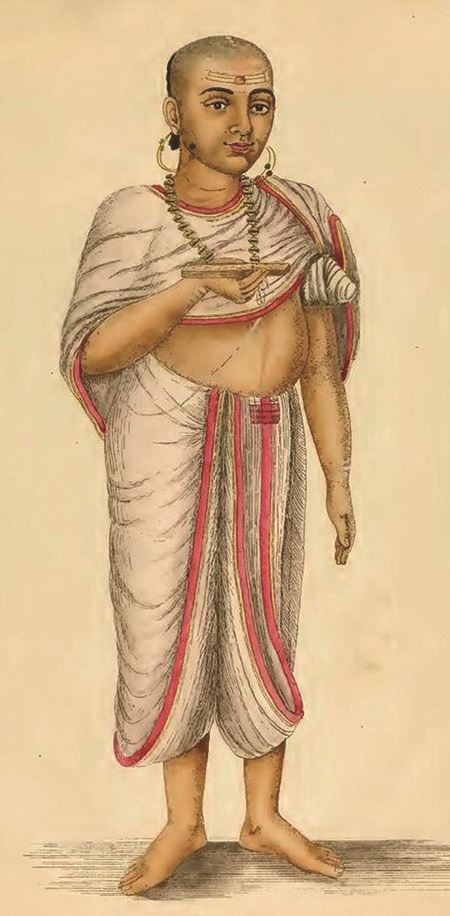
Illustration of a member of the Brahmin caste from the nineteenth century
The Vaishya caste was originally farmers, but grew to also include merchants, artisans, and people with other skilled professions. Their social status was lower than the Brahmins and Kshatriyas, but some Vaishyas become very rich through trade—often wealthier than those in the castes above them. Members of these three castes were the only members of society considered dvijas, meaning “twice-born.” This is because men in these castes could undergo the upanayana coming-of-age ceremony that was considered a spiritual rebirth.
The lowest, Shudra caste, formed the largest rung on the Hindu social ladder. Shudras were the laborers, servants, and unskilled workers. Many worked in agriculture, but usually as farmhands rather than wealthy farmers with their own land. Shudras were seen by the other castes as lacking spiritual refinement, and were denied the opportunity to become dvijas. They were responsible for tasks considered too menial or undignified for members of the other castes.

A group of Dalít untouchables near Bangalore, India in the early twentieth century
Those who were not in any of these castes were known as Dalíts, often called outcastes or untouchables. These were people so low on the social scale that everyone else avoided them as much as possible. They had jobs that were ritually impure, like cobblers, or highly unsanitary, like sewer cleaners. Partly because of this association with bodily fluids and human waste, members of the four castes believed that they would be polluted by even touching a Dalít. As a result, Dalíts lived on their own outside main communities, and were excluded from most social interactions. This led to severe poverty for the Dalíts, with little opportunity for education or self-improvement.
Although the Laws of Manu describe the general rules governing Hindu society, historians now believe that there was some flexibility. For example, talented people born into part of a caste that performed one kind of job could occasionally succeed at a different occupation. And in some cases, people from different castes married each other despite this being officially forbidden. Still, the overall effects of the caste system were to reduce social and economic mobility. According to many interpretations of Hinduism, it is praiseworthy to cheerfully fulfill the role you are born into in life, rather than trying to achieve a different status. Hindu beliefs said that this could lead to reincarnation at a higher status in your next life.
During most of British rule in India, the caste system was accepted by the colonial administrators. Although they did not believe in the religious justifications for dividing people by caste, they found these beliefs useful for keeping the population peaceful and discouraging rebellion. In addition, now-discredited scientific theories of that time said that the castes represented important biological differences in intelligence and morality. Thus, the British believed that members of the higher castes were naturally more fit for important jobs, and put them in leadership roles over the lower castes.
By the early twentieth century, both the British and the foreign-educated Indians pushing for independence recognized that the caste system was unjust and without justification. India’s participation in World War I and World War II caused many of its people both to interact more with those from other castes, and to meet people from foreign cultures. This increased support for tearing down caste-based prejudices. Meanwhile, the British started reserving certain jobs and local government seats for disadvantaged castes. Mahatma Gandhi (1869–1948), the leader of the independence movement, supported equality and civil rights for all castes, and opposed the mistreatment of untouchables. Although he was born in the Vaishya caste, he actively spoke on behalf of the untouchables.
When India gained its independence in 1947, it began working on a national constitution, and when this constitution came into force in 1950, it formally abolished the caste system. Still, serious discrimination against people with low-caste or outcaste backgrounds has continued. As a result, India has enacted a series of laws and policies meant to remedy injustices to groups that Indian law recognizes as “Scheduled Castes” and “Scheduled Tribes.” This includes affirmative action programs that increase educational access and ensure that certain proportions of government jobs and legislative seats go to people in those groups.
The result has been that people from low-caste and Dalít families are now much better represented in high positions of Indian society than they were several decades ago. As a notable example, Rajesh Saraiya became India’s first Dalít billionaire in 2011. Despite this progress, though, the former “untouchables” remain underrepresented at the top levels of wealth and power, and social prejudices against them remain. Much progress is yet to be made.
![]()
In the alternative reality of Danielle: Chronicles of a Superheroine, as president of China, fifteen-year-old Danielle works to resolve ethnic tensions within the Chinese population, but she expresses relief that these are not as serious as those within Indian society as a result of the lingering effects of the caste system.
See entries for India’s Hindu-Muslim conflict and the East India Company.
219. Uyghur Muslim separatists
The Uyghurs (pronounced WEE-gurz in English) are an ethnic group in Central Asia that primarily lives in the Xinjiang Uyghur Autonomous Region of the People’s Republic of China. They share common ancestry with the Turks and mainly speak a language related to Turkish. Most Uyghurs practice Islam, which conflicts with the officially atheist policy of China’s communist government. As a result, there have been religious tensions ever since China formally claimed sovereignty over the Xinjiang region when the People’s Republic was established in 1949.
In response to unrest in Xinjiang, the Chinese government granted it autonomous status in 1955. This meant that the local Uyghur population got some control over the local economy and civic administration. But the communist officials in Beijing still controlled the most important functions of government. When relations between China and the Soviet Union broke down during the 1960s, the Russians began encouraging a Uyghur movement seeking full independence.
The Uyghur independence movement hopes to turn Xinjiang into a sovereign nation called East Turkestan. It would be an Islamic country, and more accommodating to the Uyghurs’ religious, cultural, and educational practices. For example, many Uyghurs resent that some with government jobs have not been allowed to observe Islamic fasting during the holy month of Ramadan. In addition, Uyghurs feel threatened by the immigration of ethnic Han Chinese into Xinjiang from elsewhere in China. The government in Beijing encourages Han people to settle in Uyghur-majority areas, which means that the Uyghurs may eventually become a minority in their own homeland. As of the 2010 census, Han Chinese now make up more than 40 percent of the Xinjiang population.
Yet it has been difficult for other nations and human rights groups to support the Uyghur cause, because many members of the East Turkestan independence movement support a radical interpretation of Islam that seeks to oppress people of other faiths, and limits the rights of women.
This faction of the movement became stronger in the 1980s, when the United States and its allies began supporting groups of extremist Muslims in nearby Afghanistan as a way to counter the Soviet invasion there. In April 1990, protests and violent riots broke out in Baren, Xinjiang, and were followed by a harsh government crackdown. Hundreds were killed. Similar incidents continued around Xinjiang for several years afterward.
For the last two decades, the violent wing of the Uyghur movement has been represented by the Turkistan Islamic Party (TIP), which has been widely condemned as a terrorist organization. The TIP has sponsored numerous attacks on civilians in China and elsewhere in Asia, especially since a period of clashes between Uyghur protesters and government forces in 2008. For example, a 2008 Uyghur terrorist attack in Kashgar killed 16 police officers. In 2014, knife-wielding TIP terrorists attacked a railway station in Kunming in southern China, killing 31 and injuring almost 150. Another series of attacks later that year in and around Yarkand, Xinjiang killed dozens and led to forceful reprisals by the government. In 2015, Uyghur terrorists killed 50 Han Chinese workers in a coal mine. A steady rhythm of smaller attacks and incidents still continues.
The United States has taken the position that it cannot support Uyghur independence, both because of its need to preserve good relations with the government in Beijing, and because the independence movement prominently features terrorists like the Turkistan Islamic Party.
![]()
In the alternative reality of Danielle: Chronicles of a Superheroine, when Danielle becomes president of China, she sends Liu and Claire to work toward diplomatic solutions to the conflict with Uyghur Muslim separatists.
See entries for Han Chinese, Jihad, Infidels, and Chinese Communist Party.
220. Silicon Valleys
Around the time of World War II, many high-tech American companies were founded in or moved to the area around San Jose, California. A major reason for this was the presence of Stanford University in nearby Palo Alto, which provided a large pool of engineering talent and research facilities. Starting in the 1950s, this area became the hub of the American semiconductor industry, as companies like Fairchild Semiconductor, Shockley Semiconductor Laboratory, and Intel were established near San Jose. Since the circuits used to make modern computers are made from semiconductor devices, it made sense that other computer-related companies would be founded nearby or relocate to take advantage of the skilled workers and resources already there. Since silicon is the most common semiconductor material, the region came to be nicknamed “Silicon Valley.”
Starting in the 1970s, the San Jose and the Santa Clara Valley became the hub of the personal computing revolution. Cupertino-based Apple Computer played a key role in transforming computers from purely functional devices used by businesses and universities, and making them user-friendly and accessible to ordinary people for learning, creativity, and entertainment. Then, in the 1990s, Silicon Valley became the center of the Internet revolution. Entrepreneurs with ambitious ideas came from all over the world to take advantage of the superstar programmers and easy access to investors familiar with computing. In fact, there was so much hype and investment that stock prices for Internet companies spiraled upward, forming an unsustainable “bubble.” Because so many of these companies were websites, this came to be known as the Dot-Com Bubble, which burst in 2000 when investors realized that prices couldn’t keep going up, and rushed to sell their stocks.
Even though the bubble burst, there was so much high-tech talent in Silicon Valley that it soon made a recovery. In the decade after the crash, companies like Google, Facebook, and Amazon created innovative services that greatly improved life for billions of people around the world. This has generated trillions of dollars of economic activity. Today, Silicon Valley remains the world’s number one location for new technology startups.
Because Silicon Valley is so widely associated with technology and innovation, other hubs of high-tech activity have been given nicknames that refer to it. For example, the area around Cambridge, England is home to hundreds of tech startups, and is known as “Silicon Fen.” The cluster of software companies in Santa Monica and Malibu, California is called “Silicon Beach.” In Israel, where “wadi” means a dry valley, the area famous for advances in computing is called “Silicon Wadi.” Similar nicknames have been applied to “Silicon Fjord” in Norway, “Silicon Cape” in South Africa, and many other places.
Sometimes, “silicon valley” is used metaphorically to describe clusters of high-tech companies even if the area is known by a different name. For example, one of the world’s most notable emerging silicon valleys is an area of Beijing called Zhongguancun. Much like the original Silicon Valley, the Zhongguancun area has top research institutions like Peking University and Tsinghua University. Also, highly successful tech companies like Lenovo are already established there, so talented scientists and engineers already live nearby.
All over the world, governments are trying to create similar conditions. From city governments all the way up to national governments, elected officials are promoting their regions as new “silicon valleys” in hopes of creating self-reinforcing cycles of investment and innovation. Successful technology hubs create thousands of high-paying jobs, billions of dollars in tax revenue, and inject large amounts of money into the local economy. Often, leaders try to focus on a particular area of technology to have a better chance of standing out, such as biotechnology, artificial intelligence, or robotics. In some cases, governments invest in new companies directly, and in other cases they try to attract entrepreneurs with tax incentives and research facilities.
![]()
In the alternative reality of Danielle: Chronicles of a Superheroine, when Danielle becomes president of China at age fifteen, she promotes entrepreneurship and technological innovation. As a result, Zhong-guancun is joined by a dozen other silicon valleys throughout China. Danielle’s efforts pay off, and GDP growth rates rise from 7 percent a year to 9 percent a year.
See entries for Artificial Intelligence, Series A Investment, and Sovereign funds.
How You Can Be a Danielle and start your own company.
221. Beijing smog
Major urban areas are often affected by the kind of air pollution known as “smog” from a combination of the words “smoke” and “fog.” Smog forms from a mixture of moisture in the air and emissions, like the exhaust from cars, furnaces, and factories. During the Middle Ages and Industrial Revolution, smog was a major problem in European cities, because the easiest and cheapest way to heat buildings during the winter was burning large amounts of coal, which gives off thick dark smoke. The soot in the air would stain buildings black, ruin clothing, and damage people’s lungs. When this pollution mixed with the right weather patterns, it could cause heavy clouds of smog to settle over cities. In December 1952, there was such a severe smog event in London that visibility was reduced to almost nothing and over 4,000 people died.
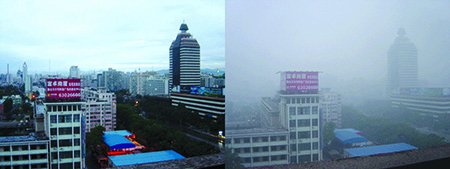
Beijing on a day with good air quality (left), versus Beijing on a smoggy day (right)
Following this so-called “Great Smoke” in London, American and European cities made urgent efforts to reduce pollution. They phased out coal-burning furnaces, tightened vehicle emissions rules, and shifted heavy industry away from city centers. It took decades and a lot of focused effort, but now cities like Los Angeles, which were once famous for thick blankets of smog, have much improved air quality. On the other hand, cities in many developing countries have been in such a hurry to develop their economies that they have not yet established strict pollution rules. Due to a combination of heavy pollution and local weather conditions, Beijing, China is known for particularly hazardous smog.
Not only does Beijing produce a lot of pollution from its population of almost 25 million, but prevailing winds also bring polluted air from surrounding areas. Masses of warm air often lie high over Beijing, which traps smog in a layer of cool air closer to the ground. This smog can have serious health effects, and levels of air pollution have reached about 40 times the limit of what the World Health Organization considers safe. As a result, many people in Beijing wear masks outdoors to prevent some of the harmful particles in the air from irritating their lungs. According to a report by the New York Times, as of 2015, air pollution caused about 1.6 million deaths a year in China.
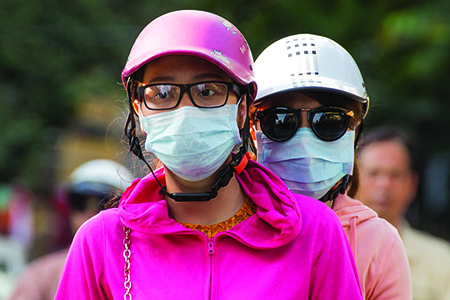
Beijing residents wearing surgical-style masks to protect their lungs when outdoors
In recent years, the Chinese government has increased efforts to reduce pollution in Beijing. Old cars that produce dirty exhaust are being phased out, and new restrictions limit when and how much factories can pollute. Major efforts to cut down smog during Beijing’s 2008 Summer Olympics were temporary but made a significant improvement.
![]()
In the alternative reality of Danielle: Chronicles of a Superheroine, when Danielle is elected president of China at age fifteen, she encourages new technologies and enacts reforms that help the environment. This reduces air pollution and improves water quality, and brings great benefits to the capital. Soon, Beijing goes four whole months without a smog alert.
See entry for World Health Organization.
222. Chinese IP protection
As more and more of the economy becomes digital, there has been an increasing worldwide focus on intellectual property. Intellectual property, or IP, is the legal term for the protections governments grant to protect people who produce creative work. The idea behind IP law is that if someone comes up with a new invention, writes a computer program, composes a song, or gives their business a clever name, other people shouldn’t be allowed to steal those ideas. If theft was allowed, there would be much less incentive to invest time and money in producing creative work. So laws in most countries say that creators have the exclusive right to use their ideas for a certain period of time. They can either use this time to start a company that markets the idea to the public, or they can license the rights to other companies in return for compensation. IP protection takes the form of patents (which protect inventions, generally for about twenty years), copyrights (which protect the expression of an idea such as a song or written work, generally for about 70 to 80 years), and trademarks (which protect names of products and companies).
The Internet makes enforcing IP law difficult. Back when software came on physical objects like floppy disks or CD-ROMs, it was easier for governments to track down people who were making illegal “pirated” copies of computer programs. But now, someone can buy a copy of software legally, and then put it online for people to download. The pirates often profit from this—either by charging a small fee for the download, or by generating advertising traffic to their websites. This is hard to stop, because stolen IP hosted on servers in one country can be accessed all over the world. For this reason, the United Nations created WIPO, the World Intellectual Property Organization. WIPO helps nations cooperate to prevent theft of intellectual property. Unfortunately, although the People’s Republic of China is a member of WIPO, violations of IP are still very common there.
According to US estimates, China is responsible for at least half of all thefts of American intellectual property. This includes a wide variety of actions, including individuals pirating software, companies manufacturing and selling patented products without permission, and counterfeiters producing imitations of branded clothing. In some cases, intelligence analysts believe, Chinese hackers break into the computer systems of American companies and steal their trade secrets.
As a result of this pattern of IP theft, other nations have criticized Chinese actions and demanded that its leaders enforce international intellectual property rights. In 2015, under threat of US sanctions, the government in Beijing agreed to stop using government spying to steal intellectual property for commercial purposes. On the other hand, the agreement did not cover spying for national security purposes, and analysts worry that China interprets “national security” to include commercial activities in sectors like aerospace, energy, and electronics.
![]()
In the alternative reality of Danielle: Chronicles of a Superheroine, after being elected president of China at age fifteen, Danielle realizes that the country needs to place more focus on upholding IP law. This has two main benefits: First, it makes other countries more eager to trade with China and make investments there; second, it means more protections for Chinese innovators who are creating new intellectual property of their own. This helps Danielle bring new prosperity to the Chinese people.
